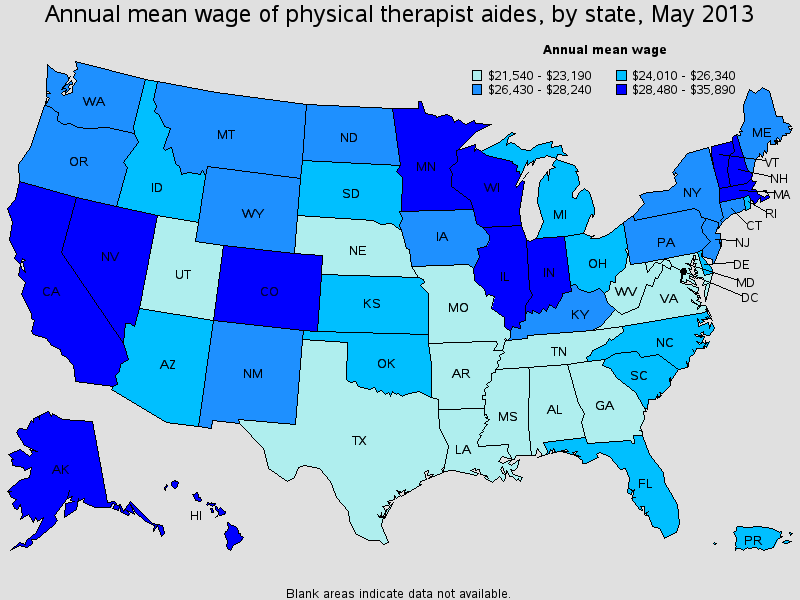What is a Physical Therapy Aide
Professionals who move and lift sick, injured, and disabled patients are called physical therapy aides. They also help people regain functions and cope with pain. Working under the supervision of physical therapists and physical therapy assistants, these aides ensure that treatment areas are properly supplied with medical equipment and materials. They maintain patient records and perform other administrative tasks, but do not provide direct patient care. For more on job duties, please visit our physical therapy aide job description page.
Work Environment
Most physical therapy aides are employed in professional medical and nursing-care facilities. These sites generally feature safe and sanitary conditions. Aides who work for home health-care services may encounter less predictable environments. There is a risk of infectious disease, and injuries can happen while moving patients or equipment.
Aides require the agility and strength necessary to lift and support patients, and position heavy medical machinery. Stressful situations can result from patients’ pain, discomfort, frustration, and fear. Aides should be a reassuring presence, demonstating patience and understanding. Good communication skills are crucial.
Work Schedule
Most aides work full time, on weekdays, with some putting in overtime. About 25 percent have part-time positions. Those in home health-care services are often expected to be available in the evenings and on weekends.
Mean Annual Physical Therapy Aide Salary
The average annual physical therapy aide salary in the United States, according to the latest report from Bureau of Labor Statistics, was $25,990. The top 10 percent of earners made more than $36,390, while the bottom 10 percent received less than $17,820.
Physical Therapy Aide Salary: Quick Summary
| 2013 Mean Salary | $25,990 per year $12.50 per hour |
| Top 10% Salary | $36,390 per year $17.49 per hour |
| Bottom 10% Salary | $17,820 per year $8.57 per hour |
| Number of Jobs, 2013 | 48,630 |
Physical Therapy Aide Job Outlook and Prospects
Few, if any, careers have better prospects than those related to physical therapy. CNN recently included the industry on a list of “Best Jobs for Top Growth,” and U.S. News and World Report rated it among the “50 Best Careers.” U.S. government analysts project a 40 percent increase in the number of aide jobs during the decade ending in 2022. That would amount to 20,100 more positions. The average job growth for all occupations is only expected to be about 14 percent.
More aides will be needed due to the expanding population, especially the rapidly rising number of senior citizens. The elderly tend to need more physical therapy than younger people, as their bodies degenerate and become more prone to injuries. Another factor in the job growth is an increase in patients suffering from diabetes and obesity, conditions that can lead to physical ailments.
Physical Therapy Aide Salary: Factors of Influence
In the past 2 years, the average annual wage for physical therapy aides has increased slightly from $25,110 to $25,990. This reflects just over 1% of increase in the average salary which is on par with the United States inflation rate of 1.60% as of January, 2014.
However, not all physical therapist aides will make the same amount of money. This is increasingly true when you consider a variety of influential factors such as experience and specialization, industry, and location.
Education and Specialization
Graduating from high school is usually the only educational requirement for a physical therapy aide. Training is provided on the job. Experts recommend taking classes in physical therapy and fitness (available at community colleges and technical schools, as well as online). Some schools offer physical therapy aide certificate programs. Students may gain practical experience by volunteering at hospitals or clinics.
Some employers want their aides to be certified in CPR and first aid. No state license or professional certification is offered for this entry-level position. Some of the greatest job growth is expected for physical therapy professionals who specialize in acute hospital care, skilled nursing, and orthopedics.
Additional education and training, as well as certification, are required to be eligible for promotion to physical therapy assistant or to become a licensed physical therapist. Most states mandate that assistants, whose salaries average nearly twice as much as those of aides, have associate’s degrees in physical therapy.
Industry
More than half of all aides work in physicians’ offices and clinics featuring multiple practitioners, including physical therapists. The second-largest employers are hospitals, followed by home health-care services and nursing-care facilities. The biggest rates of job growth are projected to occur in hospitals, nursing homes, assisted-living complexes, and other facilities that serve seniors.
The top salaries in the field are found at psychiatric and substance-abuse hospitals, where aides average about $40,000 a year. Hospitals and nursing homes typically pay more than physicians’ officcs and medical clinics.
Location
While many more physical therapy aides are expected to be needed everywhere in the future, their services will be in the greatest demand in rural areas. However, cities and suburban areas will continue to provide the most positions because of their populations.
Metropolitan areas with high concentrations of seniors may be the most lucrative locations for aides. Places where people are more physically active also are likely to need more therapy services.






